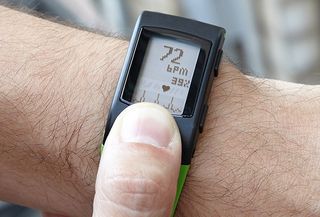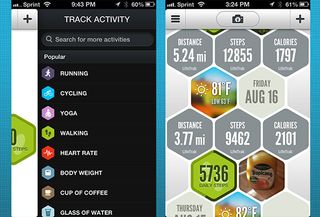Salutron LifeTrak Move C300 Review
The affordable LifeTrak Move C300 tracks your daily activity and syncs it via Bluetooth with your iPhone.
Why you can trust Tom's Guide

Want to know how much (or how little) you move during the day? Looking to improve? The LifeTrak Move C300 is a watchlike device that keeps tabs on your daily activity and syncs with the colorful Argus iOS app via Bluetooth. But with so many fitness trackers already available, how does the $59 C300 place?
Editor's note: Portions of this review were taken from our previous review of the MapMyFitness Sync Burn.
Design
Considering the world of fitness gadgets is still relatively small, we were somewhat surprised to see that the LifeTrak Move C300 has an identical design to that of the MapMyFitness Sync Burn.
Unlike fitness wristbands, such as the Jawbone UP and Fitbit Flex, the C300 has an LCD that lets you see, at a glance, the time and your progress toward your daily goals. The outside of the wristband is made of black plastic to match the face of the watch, and it's green on the inside. (You can also reverse the band so that the green side is facing out). We like that the band has plenty of holes, allowing our skin to breathe.
The Move C300's screen measures 1.1 x 0.6 inches, and although it's an old-school LCD readout, it's backlit and incredibly easy to view in direct sunlight. We also like that the display remains on constantly, so you can view the time and date without having to press any buttons.
MORE: Smartwatches: Why Their Times Has Finally Come
In comparison, the Withings Pulse's smaller touch-screen display has a sleeker interface. However, you have to press a button to turn it on, and it's nearly impossible to view in sunlight. Also, when you have the Pulse in its wristband, the screen is partially obscured by the mesh covering on the band.
Interface

At the top of the C300's home screen is a status bar that fills up as you meet the day's goals you set for yourself. Beneath that are the time and date, and at the bottom is an odometer that shows how far you've traveled that day. Press the button at the bottom of the display, and you can see how many steps you've taken and how many calories you've burned.
Press the top button on the side once to display how active you've been on an hourly basis; press it again to show your progress for the week. Press the top button a third time to show the Workout screen.
If you press both side buttons simultaneously, the Sync Burn's backlight turns on for a few seconds.
Heart Rate
The button below the C300's screen doubles as a heart-rate sensor; hold your thumb down on the button, and after a few seconds, the device will show your heart rate on the screen. It's a feature that's being incorporated into many more wearable fitness gadgets, but it's not as convenient to use as the ones on the Mio Alpha or the Withings Pulse. Those two devices mount the sensor on the underside, so it's automatically in contact with your skin whenever you strap it on. Just like on the Sync Burn, you have to press the C300's button fairly hard in order for it to enter heart-rate mode. As a result, we weren't able to consistently measure our heart rate.
MORE: Best Fitness Trackers
Argus App

When it comes to wearable tech such as the C300, the hardware is only half of the equation. Fortunately, the free Argus iOS app that pairs with the C300 is a refreshing take on fitness apps. After downloading the software, you can either register with Argus or sign in using your Facebook account.
The app's home screen is made up of hexagons arranged in a honeycomb pattern, and they're filled in as you accumulate fitness data. For example, a green hexagon shows how many steps you've taken, a red hexagon displays your last recorded heart rate, another shows the weather and yet another shows the date. Pressing the Steps hexagon opens a new screen showing a timeline, so you can see when during the day you were most active.
The hexagons are arranged by date, so scrolling vertically lets you glance at what you did in a given day. In all, it's an innovative take, and it's just as fun and intuitive to navigate as Withings' app is.
At the top of the home screen is a camera icon with a fork in the middle; you can use this part of the app to take photos of your food. Three bars on the upper left open a menu, where you can drill into different areas: Food, Friends, Goals, Trends, Devices & Apps, and Settings.
A plus sign on the upper right of the home screen opens a menu that lets you track various activities. By default, it displays running, cycling, yoga, walking, heart rate, body weight, cup of coffee, sleep and workout. A search bar at the top lets you add additional activities, which include everything from alcohol to Zumba.
It's nice that Argus lets you take a snapshot of whatever you eat or drink, but unfortunately, it doesn't go beyond that. For example, you can't add a specific amount of what you ate or drank, or the number of calories.
MORE: 40 Best Free Apps for iPhone
Although this part of the MapMyFitness app is somewhat confusing — there are nine different entries for a generic 8-ounce glass of orange juice, each with a different calorie count — at least it offers the ability to more accurately track what you're ingesting. Withings' app doesn't include food tracking, but you can link it to MyFitnessPal, where you can record your daily intake.
Interestingly, you can sync the C300 with the MapMyFitness App, and vice versa, so if you don't like one app, you can always use the other.
Performance

Unlike watches designed especially for running, such as the TomTom Runner, the C300 only has an accelerometer, and not GPS. Still, for general activities, the C300 was fairly accurate in measuring the distance we walked.
We also like that the C300 has a calibration feature, so it can more accurately measure how many steps you take in a given day. However, you can only switch among three different settings (for those with a light, normal or heavy gait); the middle setting should suffice for most people.
Battery Life
The C300 has an estimated battery life of one year, which is far longer than the two-week battery life on the Withings Pulse. However, when the C300's battery dies, you must replace it, whereas the Pulse recharges via USB.
MORE: 10 Best Fitness and Workout Apps
Verdict
Though we weren't completely enamored with the C300's design — we had the same issues with the heart-rate monitor as we did when reviewing the $130 MapMyFitness Sync Burn — it's hard to ignore the C300's much cheaper $59 price. The Argus app's interface is more colorful and engaging, but it doesn't let you record as much information as MapMyFitness does. Of course, considering you can use the C300 with MapMyFitness, you could purchase the former, and use it with the latter.
While its display is harder to read outdoors, the $99 Withings Pulse has an easier-to-use heart-rate monitor, can track your sleep and has a more colorful app. But, for a lower price, the LifeTrak Move C300 is an effective tool for tracking your daily fitness.
Follow us @tomsguide, on Facebook and on Google+.
Follow Mike on Google Plus.
Sign up to get the BEST of Tom’s Guide direct to your inbox.
Upgrade your life with a daily dose of the biggest tech news, lifestyle hacks and our curated analysis. Be the first to know about cutting-edge gadgets and the hottest deals.

Michael A. Prospero is the U.S. Editor-in-Chief for Tom’s Guide. He oversees all evergreen content and oversees the Homes, Smart Home, and Fitness/Wearables categories for the site. In his spare time, he also tests out the latest drones, electric scooters, and smart home gadgets, such as video doorbells. Before his tenure at Tom's Guide, he was the Reviews Editor for Laptop Magazine, a reporter at Fast Company, the Times of Trenton, and, many eons back, an intern at George magazine. He received his undergraduate degree from Boston College, where he worked on the campus newspaper The Heights, and then attended the Columbia University school of Journalism. When he’s not testing out the latest running watch, electric scooter, or skiing or training for a marathon, he’s probably using the latest sous vide machine, smoker, or pizza oven, to the delight — or chagrin — of his family.
